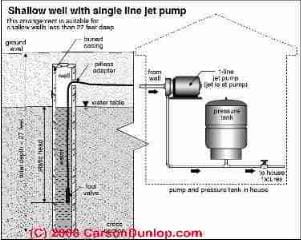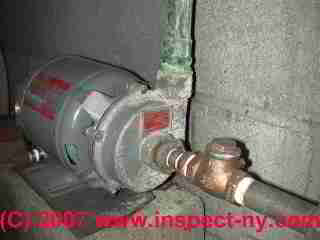 How Does a One Line Jet Pump Well Water Pump Work?
How Does a One Line Jet Pump Well Water Pump Work?
- POST a QUESTION or COMMENT on single line jet pump installation, maintenance, troubleshooting, repair
Single line jet pumps on wells: This article describes the sequence of operating steps in a one-line jet pump water system. The process of diagnosis and the costs of the repair are explained.
InspectAPedia tolerates no conflicts of interest. We have no relationship with advertisers, products, or services discussed at this website.
How a One-Line Jet Pump Well Water System Works - Sequence of Operating Steps
 What happens when you turn on the water at a faucet in a building whose water is supplied by a one-line jet pump? (See the sketch at the top of This article for the basic components of a one-line jet pump system.) Our photograph (left) shows a one-line jet pump installed in a home.
What happens when you turn on the water at a faucet in a building whose water is supplied by a one-line jet pump? (See the sketch at the top of This article for the basic components of a one-line jet pump system.) Our photograph (left) shows a one-line jet pump installed in a home.
Notice that there is a horizontal pipe with a check valve? That's the pipe leading to the water source. (We explain this check valve
at WELL PIPING CHECK VALVES.)
The vertical pipe rising from the pump is the jet pump outlet connection that sends pressurized water to the water pressure tank and onwards to the rest of the building.
The following steps describe normal operating of a building well pump and water supply system.
In other cases in which the well pump controls are not working properly there is a problem with the controls, pressure tank, pump, or well itself.
See WELL WATER PRESSURE DIAGNOSIS.
- Turn on building water at a plumbing fixture: open a sink valve, tub valve, or flush a toilet.
- Water runs out of the supply faucet, into the fixture, down the drain
- Water pressure and flow are being supplied to the building from a water pressure tank. If we didn't use a pressure tank, because water is not very compressible, the second water was turned on, water pressure in the system would drop below the pump cut-on pressure, the pump would turn on, and probably bring water pressure up to the cut-off pressure quickly, causing short cycling and burning up pump controls or a pump motor.
See WATER TANKS HOW THEY WORK. - Pressure in the water pressure tank and in the building piping system drops down to the well pump cut-in pressure. Typically this is 20 or 30 psi on a residential water system.
- The well pump pressure control switch senses the pressure drop, closes an internal electrical relay switch to turn on the well pump.
See WATER PUMP PRESSURE CONTROL SWITCH. - The well pump motor runs, drawing water back into the building from the well by "sucking" water up from a shallow depth (a one-line jet pump can't draw water from much below 25 feet)
- Water is forced into the building water pressure tank and simultaneously into the building piping and on to the plumbing fixtures.
- If the pump sends water into the building faster than water is flowing out of the open faucet or plumbing fixture, the pump will "get ahead" of the water flow, successfully pressurizing the water tank, causing the pressure switch to turn off the pump (see step 10 below).
OR - If the pump cannot send water into the building faster than water is flowing out of the open faucet or plumbing fixture, the well pump will run continuously and water will flow out of the open faucet or plumbing fixture at a rate limited basically by the pump's water delivery flow rate in gallons per minute.
You'll also find this condition if a building water supply pipe bursts. We say "basically" because the well piping and building piping and faucets themselves offer some back-pressure against the pump's flow rate. In this case, the well pump will continue to run until the building faucets or plumbing fixtures are turned off. At that point ... - The well pump pressure control switch senses that water pressure has increased to the cut-out point, opening its switch and turning off electrical power to the well pump. The well pump has re-pressurized the building water tank and piping up to the cut-out or cut-off water pressure.
- The foot valve closes (at the bottom of the well piping) and/or a check valve located in the building on or close to the well pump closes, preventing water and pressure from flowing backwards down into the well, losing building water pressure and possibly losing pump prime.
See WELL PIPING FOOT VALVES
and
see WELL PIPING CHECK VALVES
and if necessary
see WELL PUMP PRIMING PROCEDURE.
How to Diagnose Poor Jet Pump Water Pressure
For our complete water pressure and pump, well, and piping problems diagnostic article list,
seeWATER PRESSURE LOSS DIAGNOSIS & REPAIR.
Separately we also provide
a WATER PRESSURE PROBLEM DIAGNOSIS TABLE.
...
Continue reading at WATER PUMP, ONE LINE JET for a description of the function of each component of a one-line jet pump system or select a topic from the closely-related articles below, or see the complete ARTICLE INDEX.
Or see these
Recommended Articles
Suggested citation for this web page
WATER PUMP, ONE LINE JET OPERATION at InspectApedia.com - online encyclopedia of building & environmental inspection, testing, diagnosis, repair, & problem prevention advice.
Or see this
INDEX to RELATED ARTICLES: ARTICLE INDEX to WATER SUPPLY, PUMPS TANKS WELLS
Or use the SEARCH BOX found below to Ask a Question or Search InspectApedia
Ask a Question or Search InspectApedia
Questions & answers on single line jet pump installation, maintenance, troubleshooting, repair.
Try the search box just below, or if you prefer, post a question or comment in the Comments box below and we will respond promptly.
Search the InspectApedia website
Note: appearance of your Comment below may be delayed: if your comment contains an image, photograph, web link, or text that looks to the software as if it might be a web link, your posting will appear after it has been approved by a moderator. Apologies for the delay.
Only one image can be added per comment but you can post as many comments, and therefore images, as you like.
You will not receive a notification when a response to your question has been posted.
Please bookmark this page to make it easy for you to check back for our response.
Our Comment Box is provided by Countable Web Productions countable.ca
Citations & References
In addition to any citations in the article above, a full list is available on request.
- Mark Cramer Inspection Services Mark Cramer, Tampa Florida, Mr. Cramer is a past president of ASHI, the American Society of Home Inspectors and is a Florida home inspector and home inspection educator. Mr. Cramer serves on the ASHI Home Inspection Standards. Contact Mark Cramer at: 727-595-4211 mark@BestTampaInspector.com
- John Cranor [Website: /www.house-whisperer.com ] is an ASHI member and a home inspector (The House Whisperer) is located in Glen Allen, VA 23060. He is also a contributor to InspectApedia.com in several technical areas such as plumbing and appliances (dryer vents). Contact Mr. Cranor at 804-873-8534 or by Email: johncranor@verizon.net
- Thanks to our reader, Carole Cimitile, 2/17/2009, for reminding us that small problems like faucet o-rings, clogged faucet strainers and similar local plumbing fixture defects can have a big impact on hot water flow, cold water flow, or both hot and cold water flow and pressure problems.
- Penn State, Water Fact Sheet #3, USING LOW-YIELD WELLS [PDF], Penn State College of Agricultural Sciences, Cooperative Extension, School of Forest Resources, web search 07/24/2010, original source: http://pubs.cas.psu.edu/FreePubs/pdfs/XH0002.pdf
- Grove Electric, Typical Shallow Well One Line Jet Pump Installation [PDF], Grove Electric, G&G Electric & Plumbing, 1900 NE 78th St., Suite 101, Vancouver WA 98665 www.grovelectric.com - web search -7/15/2010 original source: http://www.groverelectric.com/howto/38_Typical%20Jet%20Pump%20Installation.pdf
- Grove Electric, Typical Deep Well Two Line Jet Pump Installation [PDF], Grove Electric, G&G Electric & Plumbing, 1900 NE 78th St., Suite 101, Vancouver WA 98665 www.grovelectric.com - web search -7/15/2010 original source: http://www.groverelectric.com/howto/38_Typical%20Jet%20Pump%20Installation.pdf
- Water Ace Jet Pump Installation Manual, instructions from Water Ace Pump Co., web search 08/28/2010, original source: http://www.waterace.com/pdf/R510%20R520%20and%20R100%20Jet%20Pumps%20Manual.pdf
Consumer hotline: 800-942-3343 - instructions for the installation and maintenance of
Water Ace shallow well pump Model R510 1/2 HP
Water Ace deep well pump Model R100 convertible 1HP and
Water Ace deep well jet pump Model R250 convertible 1/2 hp. - In addition to citations & references found in this article, see the research citations given at the end of the related articles found at our suggested
CONTINUE READING or RECOMMENDED ARTICLES.
- Carson, Dunlop & Associates Ltd., 120 Carlton Street Suite 407, Toronto ON M5A 4K2. Tel: (416) 964-9415 1-800-268-7070 Email: info@carsondunlop.com. Alan Carson is a past president of ASHI, the American Society of Home Inspectors.
Thanks to Alan Carson and Bob Dunlop, for permission for InspectAPedia to use text excerpts from The HOME REFERENCE BOOK - the Encyclopedia of Homes and to use illustrations from The ILLUSTRATED HOME .
Carson Dunlop Associates provides extensive home inspection education and report writing material. In gratitude we provide links to tsome Carson Dunlop Associates products and services.

